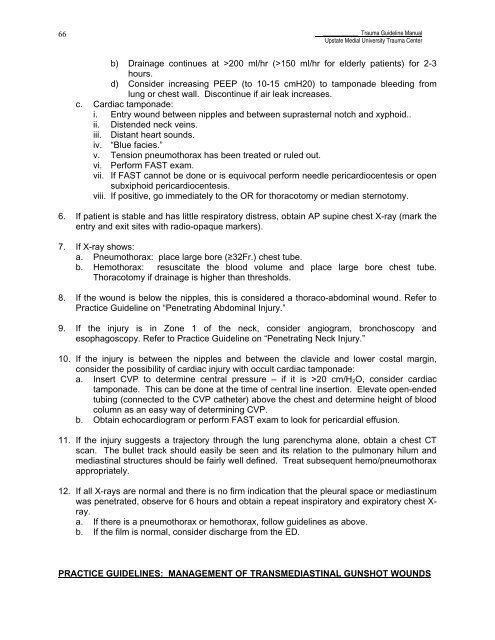Trauma Guideline Manual - SUNY Upstate Medical University
Trauma Guideline Manual - SUNY Upstate Medical University
Trauma Guideline Manual - SUNY Upstate Medical University
You also want an ePaper? Increase the reach of your titles
YUMPU automatically turns print PDFs into web optimized ePapers that Google loves.
66____________ <strong>Trauma</strong> <strong>Guideline</strong> <strong>Manual</strong><strong>Upstate</strong> Medial <strong>University</strong> <strong>Trauma</strong> Centerb) Drainage continues at >200 ml/hr (>150 ml/hr for elderly patients) for 2-3hours.d) Consider increasing PEEP (to 10-15 cmH20) to tamponade bleeding fromlung or chest wall. Discontinue if air leak increases.c. Cardiac tamponade:i. Entry wound between nipples and between suprasternal notch and xyphoid..ii. Distended neck veins.iii. Distant heart sounds.iv. “Blue facies.”v. Tension pneumothorax has been treated or ruled out.vi. Perform FAST exam.vii. If FAST cannot be done or is equivocal perform needle pericardiocentesis or opensubxiphoid pericardiocentesis.viii. If positive, go immediately to the OR for thoracotomy or median sternotomy.6. If patient is stable and has little respiratory distress, obtain AP supine chest X-ray (mark theentry and exit sites with radio-opaque markers).7. If X-ray shows:a. Pneumothorax: place large bore (≥32Fr.) chest tube.b. Hemothorax: resuscitate the blood volume and place large bore chest tube.Thoracotomy if drainage is higher than thresholds.8. If the wound is below the nipples, this is considered a thoraco-abdominal wound. Refer toPractice <strong>Guideline</strong> on “Penetrating Abdominal Injury.”9. If the injury is in Zone 1 of the neck, consider angiogram, bronchoscopy andesophagoscopy. Refer to Practice <strong>Guideline</strong> on “Penetrating Neck Injury.”10. If the injury is between the nipples and between the clavicle and lower costal margin,consider the possibility of cardiac injury with occult cardiac tamponade:a. Insert CVP to determine central pressure – if it is >20 cm/H 2 O, consider cardiactamponade. This can be done at the time of central line insertion. Elevate open-endedtubing (connected to the CVP catheter) above the chest and determine height of bloodcolumn as an easy way of determining CVP.b. Obtain echocardiogram or perform FAST exam to look for pericardial effusion.11. If the injury suggests a trajectory through the lung parenchyma alone, obtain a chest CTscan. The bullet track should easily be seen and its relation to the pulmonary hilum andmediastinal structures should be fairly well defined. Treat subsequent hemo/pneumothoraxappropriately.12. If all X-rays are normal and there is no firm indication that the pleural space or mediastinumwas penetrated, observe for 6 hours and obtain a repeat inspiratory and expiratory chest X-ray.a. If there is a pneumothorax or hemothorax, follow guidelines as above.b. If the film is normal, consider discharge from the ED.PRACTICE GUIDELINES: MANAGEMENT OF TRANSMEDIASTINAL GUNSHOT WOUNDS
















